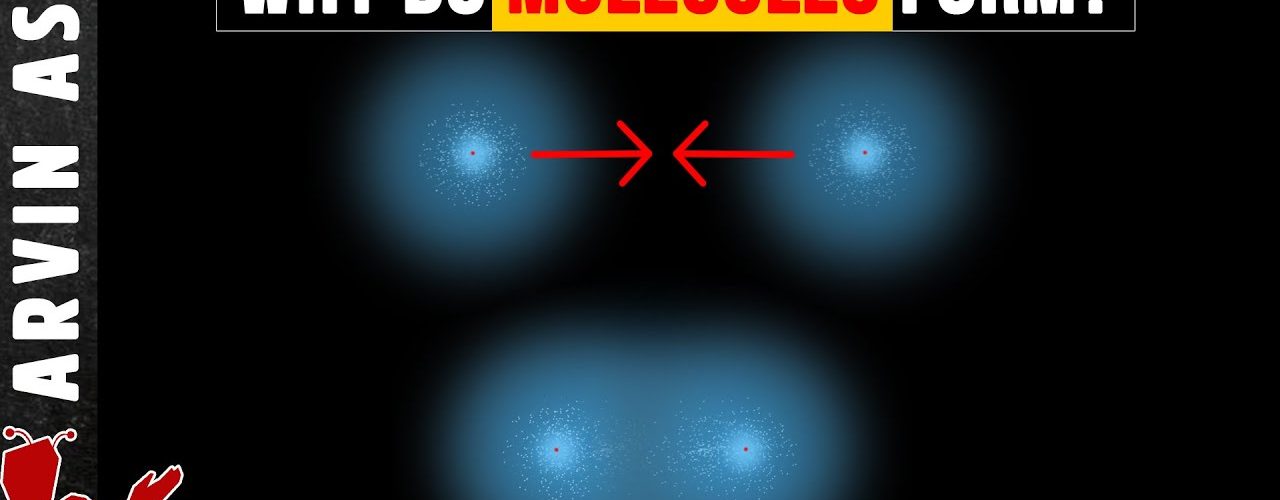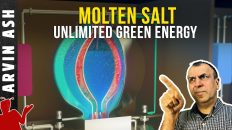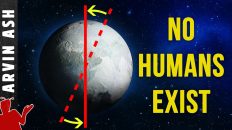Why do molecules form? Potential Energy and quantum mechanics.
Think about this. The entire universe consists of less than 100 naturally occurring elements. Yet there is immense diversity and complexity reflected in not only the myriad of substances that can be found in the universe, but also substances that can be found within your own body.
How is it that we can have a near boundless number of chemical substances with only 100 relatively simple building blocks, called atoms, to work with? This is because the 100 naturally occurring atoms are rarely found alone.
They are mostly found in combinations with other atoms, through the process of chemical bonding. The combinations of chemicals and material that can be built with these various combinations is so vast, that it can give rise not only to the variety of phenomena that we can observe in the universe, but also the complexity required to create life, fuel for the energy we need, consciousness that we enjoy, and every other macro scale process that affects us?
Why does this happen? Why is the universe not full of just about 100 different types of atoms floating around in a sea of dull monotony?
Lucky us, that these atoms bond together to form rich chemicals that have properties fundamentally different than the atoms comprising them. Why does this happen. The answer to this important question lies in understanding the role that energy plays in the formation of molecules, and its roots in where else, but quantum mechanics.
Some of the most important chemicals to us like the air we breathe consists not of individual atoms, but molecules. Oxygen for example, is not found in the air as individual oxygen atoms, but as O2 or two oxygen atoms bonded together. Nitrogen is also found as N2, two nitrogen atoms bound together. Water, without which we could not survive, is H2O – two hydrogen atoms combined with one oxygen atom.
Why are atoms prevalent mostly as molecules?
The key to understanding why atoms link together is energy. All natural systems tend to adopt a state of lowest energy.
A marble at the top of a hill has high potential energy due to gravity. If given the opportunity, it will roll naturally to the bottom of the hill where it will have a lower potential energy. This is the same reason a river flows in one direction, from high ground to lower ground.
So how does energy play a role in the formation of molecules? Let’s look at the simplest atom, hydrogen, which consists of only one proton and one electron. It is found on earth usually not as individual atoms of hydrogen, but in pairs, H2, or hydrogen gas.
By understanding the role of quantum mechanics in the formation of the hydrogen gas molecule, we can begin to understand why other atoms also form molecules in order to adopt a lower energy state.
A hydrogen atom consists of just one electron and one proton. As we saw in an earlier video, the electron forms a cloud around the nucleus. The shape of this cloud is determined by the Schrodinger equation, which contains a wave function. The wave function of the hydrogen atom, simply put, represents the probabilities of the possible results if we were to measure its properties.
The hydrogen atom by itself will be in its lowest energy state, called the ground state.
But when a second hydrogen atom is introduced into this system, some interesting things begin to happen. Not much happens if the atoms are very far apart. Both atoms are in their respective ground state.
But as they come closer to each other, a few things happen as the same time. First, the electrons since they are both positively charged repel each other, but the electron of hydrogen atom 1 also starts to get affected by the positive charge of the proton in hydrogen atom 2. Similarly the electron of atom 2 starts to get attracted to the proton of atom 1.
So the electrons of each of the 2 atoms tend to get pulled slightly to the other one’s proton. And if they get close enough, the cloud begins to spread to the space between the two atoms.
Now if the atoms get too close, then the protons begin to repel each other and push each other apart. So there is a sweet spot distance that the two protons prefer to be in, such that the electrons are happier being shared, and the protons are not too repelled to each other.
You might ask why do these two atoms get attracted in the first place because shouldn’t the electron clouds be repelling each other, and not allow them to get anywhere near each other. This is an excellent question. What you have to understand is the repulsion of the electrons is not the only interaction taking place here. There are a multitude of interactions happening.
And what happens to the entire system is determined by the total energy of the system.
To understand energy better, let’s take a look at how the energy works for the simpler system of just one atom of hydrogen by itself.
We can simplify by treating the hydrogen atom as a classical particle, it’s energy has two components Kinetic energy and potential energy.
Kinetic energy is ½ MV^2 , but let’s use momentum which is more useful in this case: p=mv, where v=p/m, then kinetic energy becomes ½ p^2/m
Potential energy is due to the coulomb force between the electron and the proton times the distance to the proton. This is expressed as negative q^2/4pi(epsilon naught)r.
To minimize the total energy, which is that state at which the atom wants to be, we have to minimize P to keep the kinetic energy low, and decrease r, in order to decrease the potential energy portion by making it more negative. But, both p and r cannot be arbitrarily small because of the Heisenberg uncertainty principle. Delta P and delta X has to be greater than or equal to h/4pi. Delta X, is the uncertainty in the position of the electron. And delta P is the uncertainty in the momentum.
So now what we can do is substitute h/4(pi)r in place of p, momentum in our equation, which now becomes the following:
E = h^2/16(pi)^2*2mr^2 – q^2/4pi(epsilon naught)r
So now we can plot energy as a function of r.
When we do that, we get a curve that looks like this:
We can see now that the minimum energy state is at the lowest point.
But the energy of two atoms of hydrogen is much more complicated than an atom by itself, because of the combinations of different interactions. To calculate the lowest energy of this two atom system, or molecule of hydrogen, we have to take into account the following:
1) The kinetic energy each atom
2) The potential energy between the two protons
3) The potential energy between the two electrons
4) The potential energy between each electron and each proton
The sum of the possible outcomes of kinetic and potential energy of this entire system in quantum mechanics is referred to the Hamiltonian, represented by capital H.
The Hamiltonian for our 2 atom hydrogen system looks something like this, when you do all the calculations:
As you might imagine, this is not a trivial equation to solve. But it can be represented for simplicity by the following graph.
And as we move the from right to left, you can see what happens to the energy when the two atoms go from being far apart to being closer together. The dip in the graph represents the lowest energy state of the two atom system. If the distance between the protons gets any smaller, the energy goes up significantly. And if the distance gets larger, it also goes up, although not as steeply.
So the two atoms find a natural sweet spot such that they are both happier being at a lower energy state together than when they were farther apart.
It turns out the energy of this two atoms system is less than the energy of two separate one atom systems. This is the reason if a bunch of hydrogen atoms are near each other, they will naturally combine to form a molecule of H2 rather than float around by themselves. This sharing of electrons by two atoms of hydrogen is called a covalent bond.
And similarly, covalent bonds formed by other atoms work analogously.
Now, if you took high school chemistry, you will know that not all atoms form bonds with atoms of their own kind, nor with just any other atom.
One of the most remarkable things about chemical bonding of atoms is that all the substances that you see all around you, comprised of molecules is due to the remarkable stability of atoms that have or share certain seemingly magical numbers of electrons – 2, 10, 18, 36, 54, or 86 electrons in so called shells around the nucleus of atoms.
And all this is due to the fact that certain combinations of atoms that contain these number of electrons tend to have the lowest potential energy.
If you look at the periodic table, you will see that these numbers correspond to the number of electrons contained in the 6 naturally occurring noble gases. These are inert elements, meaning they do not react to form bonds with other atoms under standard conditions. That’s because they already contain the number of atoms needed to form highly stable shells around the nucleus.
Other elements strive to contain a full set of electron in their outer shell called the valence shell. Any element with an unfilled outer shell has a much higher chemical potential energy than these noble gases.
So for example, if you look at the halogen compounds right next to the noble gases, fluorine, Chlorine, etc. they are only one electron away from being highly stable, so they are desperate to attract one electron from any atom that wants to get rid of one of their electrons.
Also, if you look the alkali metals on the far left side of the table, these are elements that have one too many electrons, so they are desperate to get rid of one electron. Thus, when these alkali metals get together with the halogen compounds, guess what happens? They form very strong bonds, and the resulting compounds have so much lower energy that the excess energy is released in the form of heat in an exothermic reaction.
In fact, one very important compound results from this type of reaction. It’s when Sodium bonds with chlorine to form sodium chloride, or ordinary table salt, something your body can’t live without.
So atoms can either share electrons with one or more other atoms, resulting in covalent bonds, or they can give away or take on electrons from other atoms resulting in ionic bonds. There are other types of bonds as well, but these are the only two we are discussing today.
You might ask, why are these numbers I talked about earlier such magical numbers. Chemists will say, well these are the numbers that allow atoms to fill their electron shells, or in other words, all atoms strive to form what’s called a full valence set of electrons. And this attractive force for atoms to share electrons in order to form a full valence shell, is balanced by the repulsive forces of their electron clouds and protons.
But what is the underlying reason, why should 10 electrons have lower energy than 6 electrons for example, or why is the number 18 more special than some arbitrary number like 16?
The answer lies, as many phenomena do, again in quantum mechanics. It all has to do with potential energy of multi atom systems. There are two concepts in quantum mechanics that are most important in determining the energy of these systems. The first is the Schrodinger equation as I pointed out in our example of energy related to the hydrogen molecule.
And the second is the Pauli exclusion principle. This principle basically states that no two fermions, an electron is a fermion, can occupy the same quantum state. For our purposes, this means that in a molecule, two electrons that are in the same orbital must have opposite spins.
These two principles taken together, can reproduce those exact sequence of numbers that I called magical. And solving the equations will show that these are the precise numbers that result in lowest potential energy of chemical systems.
So for example if we wanted to look at water, H2O, consisting of 2 hydrogen atoms and one oxygen atom, a wave function can be written for this structure. Energy can be calculated by solving the equations. And bond lengths can be determined that result in the lowest potential energy.
But precise calculations get very mathematically complex, so approximations called Morse potential, represented by the equation below is usually used. Plugging in the numbers, a graphical representation of morse potential for the OH bond in water….
U(r) = U0(e-2(r – r0)/a – 2e-(r – r0)/a)
U(naught) is the bond energy
r(naught) is the bond length
…can be shown as the following. Here U0 is the bond energy and r0 is the bond length that can be read from the above table.
So as usual it all comes down to quantum mechanics. But what I want to impart to you is that the quantum mechanics behind these phenomena only allows you to see how nature behaves. It does not explain why nature is the way that it is. It only shows you how nature works.
The question of why things are the way that they are is what I think the most intriguing question. And there may be some underlying reason for example that lies in string theory, or some other theory of everything. And that’s what I hope the next generation of scientists will keep pursuing.
V







